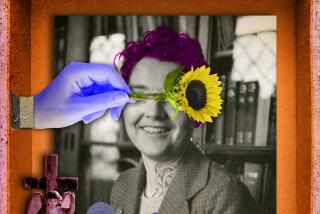‘El Iluminado’ illuminates New Mexico’s ‘crypto-Jews’
El Iluminado
A Graphic Novel
Ilan Stavans and Steve Sheinkin
Basic Books: 208 pp, $24.99
Halfway into the graphic novel “El Iluminado,” a Spanish literature professor in an Indiana Jones hat wanders into a café in Santa Fe, N.M., and receives a pearl of wisdom from a gray-haired woman.
“A Jewish soul is a Jewish soul,” the woman says. “When you have it, you know.”
The professor is a real person: Ilan Stavans, a Latino literary maven known for his insightful criticism, his authoritative anthologies and his quirky translation of “Don Quixote” into the mother tongue of millions of Americans, Spanglish.
In “El Iluminado,” Stavans is thrust into a fictional mystery about a group of real people whose history is largely unknown to most Americans: the “crypto-Jews” of New Mexico. Steve Sheinkin, with an appealing palette of earth-toned colors, creates the illustrated world in which this story unfolds.
The crypto-Jews know they have Jewish souls — but they can’t quite get other Jews, or other New Mexicans, to believe them. What’s more, their own link to Jewish history is shrouded in secrecy.
Stavans is a Mexican-born Jew of Polish descent with no doubts about his own cultural identity. But he’s fascinated by the story of people who’ve lived for four centuries with Jewish customs, often without realizing it.
“His mother never served bacon or pork, no es limpio, she’d say, not clean,” says the Santa Fe woman who guides Stavans deeper into the mystery of one crypto-Jew. “Or the way she cleaned the house, muy peculiar, always sweeping the dust to the center of the room, then throwing it out the window, never out the door.”
“That’s an old Jewish custom,” Stavans says. “The door’s threshold has the mezuza, which is a sacred item, and the dust is profane, so the two should never touch.”
The story of the crypto-Jews goes back to 1492, when the Spanish Inquisition forced Jews to convert to Christianity. Those who concealed their Jewish identity were known by the derogatory term Marranos, or pigs. And those who were caught practicing Jewish rites, or who “confessed” to belief in “the Law of Moses” were burned at the stake.
As “El Iluminado” opens, the fictional Stavans is explaining this tortured history to a Santa Fe audience. More people in New Mexico are claiming their secret Jewish history, he says, but “establishment” Jews are often suspicious of their claims.
“Ironically Marrano is now a concept infused with cachet,” he says. What the fictional version of Stavans doesn’t realize, however, is just how much the question of Jewish identity can tear apart families that have always thought of themselves as Catholic. That tension is what drives “El Iluminado” forward.
Stavans soon finds himself caught up in the investigation into the death of Rolando, a young Santa Fe man who was fighting with his family over its hidden Jewish identity. Rolando’s father believed that everyone in the family “was truly Católico, blood as pure as the Pope’s.”
Trying to piece together Rolando’s story sets Stavans off on a highly entertaining and informative journey through New Mexican and Jewish history. Rolando, we learn, was fascinated with the story of Luis de Carvajal the Younger, a 16th century Spanish Catholic. As a teenager, he learned of his family’s secret Jewish identity. He soon adopted the nickname “El Iluminado,” the enlightened one. Carvajal’s family eventually moved to Mexico, then a Spanish colony, and he became a leader of the crypto-Jews there.
Mexico’s crypto-Jews eventually drifted to Santa Fe, then on the northern frontier of the Spanish colonies in the Americas. We learn in “El Iluminado” that Jewish labor likely helped build the first Catholic shrine in New Mexico.
That shrine was burned down by an Indian revolt against Spanish rule, one of several events depicted fancifully in Sheinkin’s uncomplicated but evocative caricatures.
Sheinkin has great fun too drawing the eerie remnants of Jewish culture in New Mexico — including the four Hebrew letters of the “Tetragrammaton,” the biblical name for God, that still hover over the main entrance to the Basilica of St. Francis in downtown Santa Fe.
In the end, “El Iluminado” reads a bit like a crypto-Jewish “DaVinci Code,” as Stavans engages in verbal jousting with the obligatory police detective and with an envious and conniving academic rival.
Stavans also escapes being held at gunpoint, and at one point jumps over a church barrier to examine a centuries-old statue of the Virgin Mary — it was once said to possess a marker of her Jewish identity. The book’s thin plot, however, is merely an excuse to explore an undeniably weighty and meaningful chapter of American history, an epic tale with a tragic sweep.
“What interests me in all this is the way people create stories to survive, to affirm who they are, to make a stand,” Stavans says. That’s the deeper message of “El Iluminado,” a reminder of the human longing that often drives those who search for their “true” religious and cultural identities.
The real-life Carvajal “risked all to search for authenticity, his rightful origins” as a Jew, Stavans writes. “That’s what authenticity is all about: the personal belief that each of us is unique, that deep inside there’s a light that guides our path.”
That light burns also in certain New Mexico homes, where people have lighted candles on Friday evenings for generations — without knowing exactly why they’re doing so.
More to Read
Sign up for our Book Club newsletter
Get the latest news, events and more from the Los Angeles Times Book Club, and help us get L.A. reading and talking.
You may occasionally receive promotional content from the Los Angeles Times.











